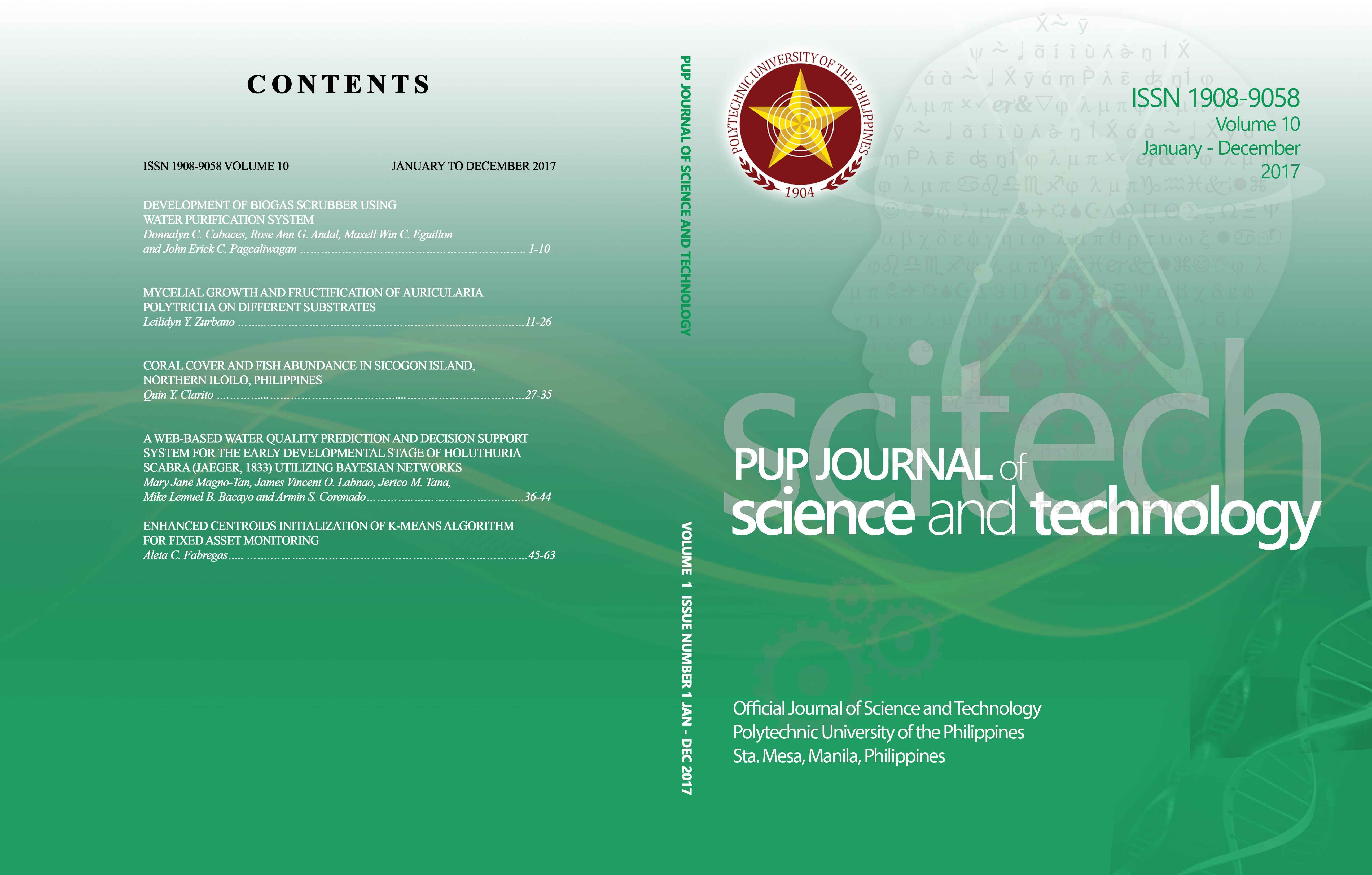Mycelial Growth and Fructification of Auricularia polytricha on Different Substrates
DOI:
https://doi.org/10.70922/sb910c47Keywords:
Auricularia polytricha, culture media, grain spawn, fruiting substrates, mycelial ramificationAbstract
Auricularia polytricha is a wood-rotting mushroom known for being one of the edible mushrooms, and recognized for its nutraceutical and pharmaceutical properties. To domesticate this species, the most favorable conditions for its mycelial growth and yield was evaluated in various culture media, grain spawn and fruiting substrates. The results revealed that A. polytricha cultured in coconut water gelatin (CWG) had the fastest mycelial ramification (6.33 days), and the thickest and highest mycelial growth at 13.17 mm/day. For spawn grain production, sweet sorghum produced the fastest mycelial run among grains at 5.0 days, had the highest mycelial growth at 16 mm/day, and had the thickest mycelia. For fruiting bodies production, the combination of good lumber sawdust, rice bran and lime (GLS:RB:L) had the fastest mycelial run at 30.33 days, highest mycelial growth (10.0 mm/day), yield (254.0 g) and biological efficiency (30.79%).
Downloads
References
Ahila Devi P., Veeralakshmi, S. Prakasam, V. & Vinothini, M. (2013). Saw dust and wheat bran substrates for the cultivation of new wood ear mushroom (Auricularia polytricha (Mont.) Sacc. American-Eurasian J. Agric. & Environ. Sci., 13 (12): 1647-1649.
Arisha, M. (2010). Optimum medium for oyster mushroom production. (Unpublished Thesis for Agriculture). http://www.academia.edu. Zagazig University. Retrieved from
Asghar, R., Tariq, M. & Rehman, T. (2007). Propagation of Pleurotus sajor-caju (oyster mushroom) through tissue culture. Pak. J. Bot., 39(4): 1383-1386.
Bahl, N. (1988). Handbook on mushrooms (2nd Ed.). Oxford and IBH Publishing Co. Ltd., New Delhi, Bombay, pp. 52.
Chang S.T. (1999). Global impact of edible and medicinal mushrooms on human welfare in the 21st century: nongreen revolution. Int J Med Mushroom, 1:1–7.
Chang, S. T., Buswell, J. A. & Miles, P. G. (Eds.) (1997). Genetics and breedings of edible mushrooms. Gordon and Breach Science Publisher. Philadelphia. USA pp. 324.
Chaurasia, V. K. (1997). Studies on production technology of Pleurotus columbines at Raipur. (Unpublished Master of Science Thesis) Submitted to I.G. K. V., Raipur:95
Custodio, Christopher D. (2004). Coco lumber sawdust. Mushroom Growers Handbook. Retrieved from http://Alohamedicinal.com
De Leon, A. M., Reyes, R.G. & Dela Cruz, T. (2013). Enriched cultivation of three wild strains of Lentinus tigrinus (Bull.) Fr. Using agricultural wastes. Journal of Agricultural Technology, 9(5), 1199-1214.
Ediriweere S.S., Wiijesundera, R. L. C., Nanayakkara, C. M. & Weerasena, O. V. D. S. J. (2015). Comparative study of growth and yield of edible mushrooms, Schizophyllum commune Fr., Auricularia polytricha (Mont.) Sacc. and Lentinus squarrosulus on lignocellulosic substrates. Mycosphere 6(6), 760-765 (2015).
Hafeez, F. Y., Shah, N. H. & Malik, K. A. (2000). Field evaluation of lentil cultivars inoculated with Rhizobium leguminosa rumbv. viciae strains for nitrogen fixation using nitrogen-15 isotope dilution. BiolFertil Soils, 31,65-69.
Irawati, D. Hayashi, C. Takashima, Y. Wedatama, S. Ishiguri, F. Iizuka, K. Yoshizawa, N. & Yokota, S. (2012). Cultivation of the edible mushroom Auricularia polytricha using sawdust based substrate made of three Indonesian commercial plantation species, Falcataria moluccana, Shorea sp., and Tectona grandis. Micología Aplicada International, Puebla, México. 24, (2), 33-41.
Jacob J.K.S., Kalaw, S.P., & Reyes, R.G. (2015). Mycelial growth performance of three species of Pleurotus on coconut water gelatin. Current Research in Environmental & Applied Mycology 5(3), 263–268. Doi 10.5943/cream/5/3/9
Khatri, R. K. & Agrawal, K. C. (2002). Studies on mushroom flora of Madhya Pradesh and Chhattisgarh with special reference to wild edible bamboo mushroom (Cantharellus Spp.) Indira Gandhi KrishiVishwavidyalaya; Raipur.
Kirk. P. M., Cannon, P.F., David, J. C. & Salpers, J. A. (2001). Dictionary of the fungi, 9th edition. CAB International, Wallingford, UK.
Kushwaha, K. P. S., Bhatt, P. & Singh, R. P. (2006). Evaluation of different substrate for yield performance of Auricularia polytricha a medicinal mushroom. Internat. J. Agric. Sci. 2(2), 389-391.
Kwon, H. & KIM, B.S. (2004). Bag cultivation. Mushroom Growers Handbook I. Retrieved from http://alohamedicinals.com
Madan M, Vasudevan P. & Sharma, S. (1987), Cultivation of Pleurotus sajor-caju on different wastes. Biol Wastes 22, 241–250.
Magday, J.R., Bungihan, M.E. & Dulay, R.M.R. (2014). Optimization of mycelial growth and cultivation of fruiting body of Philippine wild strain of Ganoderma lucidum. Current Research in Environmental & Applied Mycology 4 (2), 162–172
Martίnez-Carrera D, Aguilar A, Martίnez W, Bonilla M, Morales P, & Sobal M. (2000). Commercial production and marketing of edible mushrooms cultivated on coffee pulp in Mexico. In Coffee Biotechnology and Quality (ed. T Sera, C Soccol, APandey,S Roussos). Kluwer Academic Publishers, Dordrecht, Neterhlands. pp. 471– 488.
Mathew, A.V., Mathai, G. & Suharban, M. (1996). Performance evaluation of five species of Pleurotus (Oyster mushroom) in Kerala. Mushroom Research, 5 (1), 9-12.
Mohammadi Goltapeh, E. & Purjam, E. (2003). Principles of mushroom cultivation. Tarbiat Modarres University Press, UK., pp: 604.
Musngi, R. B., Abella, E. A., Lalap, A. L. & R. G. Reyes. (2005). Four species of wild Auricularia in Central Luzon, Philippines as sources of cell lines for researchers and mushroom growers. Journal of Agricultural Technology, 1(2), 279-299.
Nahar, D. L., Obodai, M., Baka, D. & Dzomeku. (2011). The efficacy of sorghum and millet grains in spawn production and carpophore formation of Pleurotus ostreatus (Jacq. Ex. Fr) Kummer. International Food Research Journal, 18(3), 1143-1148 M.
Onyango, B.O., Palapala V.A., Arama P.F., Wagai S.O. & Gichimu B.M. (2011). Morphological characterization of Kenyan native wood ear mushroom [Auricularia auricula (L. ex Hook.) Underw.] and the effect of supplemented millet and sorghum grains in spawn production. Agric. Biol. J. N. Am., 2(3), 407-414.
Petcharat, V. (1996). Cultivation of Wild Mushroom: VI Hed Hu Hnu (Auricularia spp.) Thai National Agris Centre. Food and Agriculture Organization of the United Nations.
Radenahmad, N., Saleh, F., Swangjaroen, K., Rundorn, W., Withyachumnarnkul B., & Connor, J.R. (2009). Young coconut juice significantly reduce histopathological changes in the brain that are induced by hormonal imbalance: a possible implication to postmenopausal women. Histology and Histopathology. 24(6), 667 – 74.
Rau, U. (1999). Production of Schizophyllan. In: Methods in Biotechnology, Carbohydrate Botechnology Protocols, C. Bucke ed. HumanaPress, Inc. Totowa, New Jersey, USA., 10, 43-55.
Rathaiah, Y and Surargiary, M. (1994). Use of parboiling paddy as spawn substrate for oyster mushroom. Mushroom Res. 1 (1), 1-3
Razak, D.L.A.B.D, Abdullah, N., Mohd N., Johari, K. & Sabaratnam, V. (2012). Comparative study of mycelia growth and sporophore yield of Auricularia polytricha (Mont.) Sacc on selected palm oil wastes as fruiting substrate. Appl Microbiol Biotechnol DOI 10.1007/s00253-012-4135-8.
Saayir, A. & Yildiz, A. (2004). Growth of mycelium of Pleurotus spp. on different grains and determination of their competition with some contaminant fungi. Acta Alimentaria. 33 (3), 249-257.
Sahu, S., Singh, K.D.P., Patel, R., & Indira, K.D.P., Vishwavidhyalaya, G. K. & Raipur, C.G. (2013). Screening of suitable grains substrates for Spawn development, growth and yield of Pleurotus eous INDIA. American International Journal of Research in Formal, Applied & Natural Sciences. 5(1), 86-89.
Santoso, U., Kubob, K., Otac, T., Tadahiro, T., & Akio, M. (1999). Nutrient composition of kopyor coconuts (Cocos nucifera L.). Elsevier Journal Article.
Sjostrom, E. (1993), Wood Chemistry. Academic Press, San Diego. Stamets, P. (2000). Growing gourmet and medicinal mushrooms; 3rd Ed. Ten speed press. Berkeley- Toronto, 153-167.
Tinoco, R., Pickard, M. A. & Vasquez-Duhalt, R. (2001). Kinetic differences of purified lacasses from six Pleurotus ostreatus strains. Lett. Appl. Microbiology. 32(5), 331335.
Veeralakshmi, S., Ahila Devi, P., Praksam, V. & Thiribhuvanamaia, V. (2014). Molecular characterization and standardization of cultivation for wood ear mushroom (Auricularia polytricha (Mont.) Sacc. International Journal of Biotechnology Research, 2(5), 60-64.
Downloads
Published
Issue
Section
License
Copyright (c) 2025 PUP Journal of Science and Technology

This work is licensed under a Creative Commons Attribution-NonCommercial 4.0 International License.







